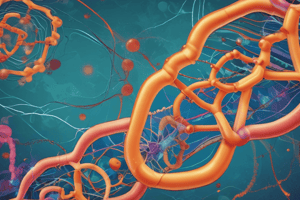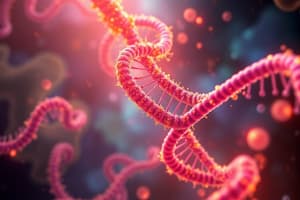Podcast
Questions and Answers
What is the primary function of transcription factors?
What is the primary function of transcription factors?
- To create the sugar-phosphate backbone of RNA
- To control gene expression by binding to the promoter (correct)
- To unwind DNA strands
- To break hydrogen bonds between RNA and DNA
What is the primary product of the transcription process?
What is the primary product of the transcription process?
- Amino Acids
- DNA
- mRNA (correct)
- Protein
Activators inhibit gene expression when bound to a promoter.
Activators inhibit gene expression when bound to a promoter.
False (B)
All cells express all genes present in their DNA.
All cells express all genes present in their DNA.
What enzyme is responsible for unwinding DNA at the promoter site and creating an RNA strand?
What enzyme is responsible for unwinding DNA at the promoter site and creating an RNA strand?
What enzyme is responsible for creating the mRNA transcript during transcription?
What enzyme is responsible for creating the mRNA transcript during transcription?
During transcription, RNA Polymerase continues until it reaches a ______ sequence in the DNA.
During transcription, RNA Polymerase continues until it reaches a ______ sequence in the DNA.
The DNA strand that is read by RNA Polymerase to create the RNA transcript is called the ______ strand.
The DNA strand that is read by RNA Polymerase to create the RNA transcript is called the ______ strand.
Match the following terms with their descriptions:
Match the following terms with their descriptions:
During transcription, RNA polymerase adds RNA nucleotides to which end of the growing RNA molecule?
During transcription, RNA polymerase adds RNA nucleotides to which end of the growing RNA molecule?
What is the result of the transcription process?
What is the result of the transcription process?
The coding strand of DNA is used as a template by RNA Polymerase during transcription.
The coding strand of DNA is used as a template by RNA Polymerase during transcription.
The entire DNA sequence is unwound during the formation of a transcription bubble.
The entire DNA sequence is unwound during the formation of a transcription bubble.
Match the following terms with their descriptions:
Match the following terms with their descriptions:
What type of DNA strand is used by RNA polymerase to create the RNA transcript?
What type of DNA strand is used by RNA polymerase to create the RNA transcript?
What is the function of a promoter in transcription?
What is the function of a promoter in transcription?
Flashcards
Gene Expression
Gene Expression
The process by which the information from a gene is used to create a functional protein.
Transcription
Transcription
The process by which a DNA sequence is copied into an RNA sequence.
RNA Polymerase
RNA Polymerase
The enzyme that reads DNA and creates an RNA transcript.
Antisense Strand
Antisense Strand
Signup and view all the flashcards
Coding Strand
Coding Strand
Signup and view all the flashcards
Promoter
Promoter
Signup and view all the flashcards
Transcription Factors
Transcription Factors
Signup and view all the flashcards
Initiation
Initiation
Signup and view all the flashcards
Activator
Activator
Signup and view all the flashcards
Repressor
Repressor
Signup and view all the flashcards
Transcription Bubble
Transcription Bubble
Signup and view all the flashcards
Terminator Sequence
Terminator Sequence
Signup and view all the flashcards
RNA Transcript
RNA Transcript
Signup and view all the flashcards
Study Notes
Gene Expression Overview
- Gene expression is the process of using DNA gene information to create a functional protein.
- All cells have the same DNA, but not all genes are expressed.
- This process involves transcription and translation.
- Transcription converts the DNA sequence into RNA.
- Translation converts the RNA sequence into amino acids, forming a protein.
Transcription
- Transcription uses DNA as a template to create an mRNA transcript.
- RNA polymerase adds RNA nucleotides to the 3' end of the RNA molecule, following the base-pairing rules of DNA.
- RNA nucleotides pair with complementary DNA nucleotides, forming hydrogen bonds.
- RNA polymerase only adds RNA nucleotides to the 3' end of the growing RNA molecule.
- Only one DNA strand is used as a template.
- The template strand is called the antisense strand.
- The complementary strand is called the coding or sense strand.
- The sense strand has the same sequence as the mRNA transcript, except thymine (T) in DNA is replaced with uracil (U) in RNA.
Transcription- Promoter
- A promoter region is a DNA sequence that marks the start site of transcription.
- Promoters are located upstream of the coding gene sequence.
- RNA polymerase, along with transcription factors, bind to the promoter.
- Specific sequences in the promoter region are essential for initiating transcription.
- Transcription factors are proteins that can either activate or repress gene expression by binding to the promoter region.
Transcription – Sequence of Events
- Initiation: RNA polymerase binds to a promoter region to start transcription and forms a transcription bubble. The transcription bubble unwinds a short section of the DNA double helix.
- Elongation: RNA polymerase adds complementary RNA nucleotides to the growing RNA molecule, using the template strand of DNA as a guide. It forms the RNA sugar-phosphate backbone.
- Termination: RNA polymerase reaches a termination sequence; usually a specific DNA sequence, leading to the release of the newly synthesised RNA, as well as the RNA polymerase from the DNA template. Hydrogen bonds between the RNA and DNA break, and the RNA molecule is released
Transcription – Transcription Factors
- Transcription factors can activate or repress gene expression by binding to the promoter (on/off switch).
- Activators increase gene expression, while repressors decrease it.
- Transcription factors bind to specific sequences in the promoter region.
- Promoters with transcription factors determine which genes are expressed.
Transcription Bubble
- A short segment of DNA unwinds at the promoter site during transcription.
- Complementary RNA nucleotides are added to the growing RNA molecule one at a time.
- The RNA polymerase creates the sugar-phosphate backbone of the RNA molecule.
- As RNA polymerase moves along the template DNA strand, the transcription bubble closes behind it.
Transcription - Termination
- Transcription ends when RNA polymerase reaches a termination sequence.
- Hydrogen bonds between the RNA and DNA break.
- Terminator proteins release the RNA polymerase and the newly formed RNA strand.
- The result is a complete RNA copy of a gene segment from the DNA.
Summary
- Transcription is the process of creating an RNA copy of a DNA sequence.
- Transcription factors regulate which genes are expressed.
- RNA polymerase initiates transcription at the promoter region.
- RNA nucleotides are added following base pairing, forming the RNA molecule.
- Transcription ends with the recognition of a termination sequence.
Studying That Suits You
Use AI to generate personalized quizzes and flashcards to suit your learning preferences.




